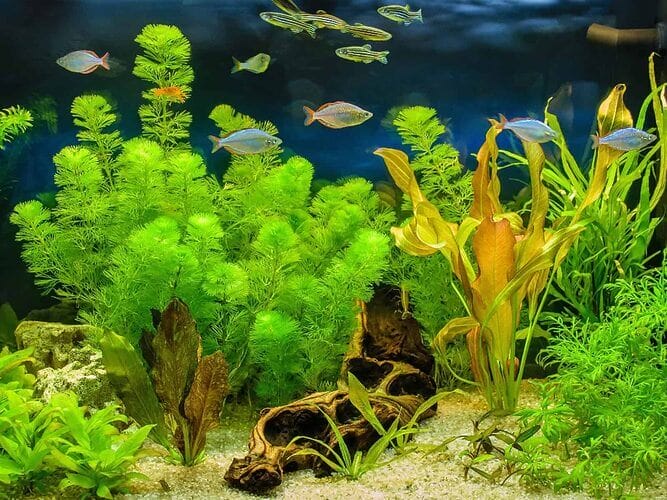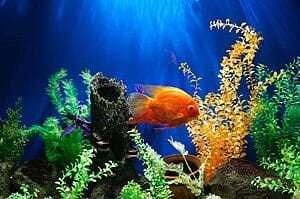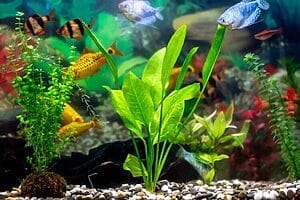Tips For Establishing Roots, Pruning And Propagating Live Aquatic Plants

Live aquatic plants can completely change the look of your aquarium. Read on to discover some easy methods for anchoring and rooting live aquatic plants as well as pruning and propagation advice. No fake plant can replace a real one, no matter how lifelike some may appear. Additionally, live plants have the added benefit of generating essential oxygen for your fish.
A lushly planted tank is a joy to behold, but getting there does require some effort. You must pick where to put your plants and how to care for them in addition to selecting the appropriate substrate for your planted tank. It can be difficult to maintain your plants where you want them since some fish have a propensity for uprooting live plants and because of other reasons like a strong current.
Read on to discover some easy methods for anchoring and rooting live plants as well as pruning and propagation advice.

Understanding the Various Aquarium Plant Types
Live aquarium plants can be purchased in a variety of methods, as you’ll discover when you first start looking around. Small pots are often used for the sale of common choices including hair grass, crypts, crinums, and Amazon sword.
Rhizomes, often referred to as rootstalks or underground stems from which roots and leaf nodes grow, are frequently sold separately from rhizomatous plants like anubias and java fern. Other plants like mosses and stem plants could be offered for sale in bunches or by the stem.
When it comes to putting them in your tank, each type of live aquarium plant needs to be handled differently. Your other plants should be rooted or tethered to keep them where you want them as floating plants will just float on the tank’s surface while moss balls will roll around at its bottom.
With potted plants , you can just place them where you want them and then cover the pot with substrate to conceal it, making this task fairly simple. However, you could require assistance from some sort of structure to which you can secure the stems when it comes to rhizomatous plants, mosses, and stem plants.

Effortless Techniques for Anchoring Live Plants
You might want to think about laying down a framework under your substrate that covers the full bottom of the tank if you intend to cultivate a densely planted tank. You can arrange the plants wherever you desire with something like plastic embroidery mesh because it won’t block water flow.
Simply lay down the mesh for this type of anchor, and then connect your root bundles to the mesh in the desired locations using cotton thread. The substrate of your choice should then be applied to the entire tank.
Use smaller pieces of plastic embroidery mesh or recycle an existing item, such as a plastic Tupperware lid, if you don’t want to plant the entire tank. To attach your plants, take the lid and make several holes in it for water flow. Then, just run the cotton thread through one hole and up through another. Once your plants have rooted, you can again position the tank lid in the desired location before covering it with substrate.
Attaching aquarium plants to a moveable tank object, such as a rock or piece of driftwood, is an additional choice for anchoring aquarium plants. If you decide to utilize rocks, make sure to pick ones that won’t alter the water’s chemistry in your tank.
Smooth river rocks work best in most cases; just make sure to thoroughly clean them before using them. At your neighborhood pet store, you may purchase aquarium driftwood or construct your own. You must cure the wood before manufacturing your own driftwood in order to get rid of the tannins. Then just set the driftwood in your aquarium and attach little plants to it using the same cotton thread.
Live Plant Pruning and Trimming
Your plants will expand swiftly if the environment in your tank is ideal and they are firmly rooted in nutrient-rich substrate. Although some plants develop more quickly than others, you will eventually need to prune your plants.
While some plants can be pruned wherever you like without harming their growth, other plants must be pruned a certain way or they will rot. How did you learn how to prune your plants, then? Depending on their personality, here are some general suggestions:
• Stem Plants – You should be able to prune stem plants correctly because they require pruning more frequently than any other aquarium plant. Trim the top two inches of stem plants to within 50% of the plant’s existing length if you want to prune them. Place clipped stems in an inch of substrate to proliferate them; after the stems develop roots, move them.
• Potted Plants – Because they often grow more slowly than stem plants, potted plants like crypts and Amazon sword plants require very little maintenance. Simply trim a few leaves at the base of the roots if the plant gets too thick; you should also occasionally do this with yellow or dying leaves. Instead of cutting the leaves directly because this can stress the plant, remove the higher leaves from the plant and let the younger leaves to flourish.
• Mosses – Many species of moss are simple to grow, particularly in areas with greater nitrate concentrations. Aquarium moss can be easily trimmed, though you might have to take the moss out of the tank to accomplish so. To keep the new moss in place, anchor it to some driftwood or rock.
• Rhizomes – You may easily prune and propagate plants like java fern and anubias by splitting the rhizome at the base of the plant and planting the pieces in the new spot.
How to Grow Various Aquarium Plants
There are various techniques for propagating live plants, just as different plant kinds require different trimming techniques. Live plants can reproduce sexually or asexually, which are the two different methods.
Asexual propagation: also known as vegetative propagation, is accomplished through the growth of runners, offsets, and plantlets while sexual propagation often involves flowers and seeds. Here is a summary of the several asexual propagation techniques used by the majority of aquatic plants:
- Runners – A runner develops from the parent plant’s base and ends with a little “slip.” After securing to the substrate, these slips start to form a completely new plant that is genetically similar to the original plant. After the runner anchors, you may either let it happen naturally or cut it off from the plant and transfer it.
- Offsets – An offset is similar to a runner, except it typically develops extremely near the main plant. To propagate the plant, you can take out the offset and plant it somewhere else.
- Plantlets – In this technique, tiny plantlets develop directly on the parent plant; they may develop on the roots, nodes, leaves, or stems of the plant. The plantlet may spontaneously separate from the parent plant once it has had a chance to mature a little, at which point you can transplant it. You can remove and replant the plantlet if it hasn’t occurred by the time it reaches a height of 3 or 4 cm.
There are three natural procedures for propagating aquatic plants, but you can also do it in a synthetic way. Taking a cutting and planting it in substrate to encourage root growth is one possibility.
Take a cutting from the top stem right above a node in a leaf, and then remove any leaves that are immediately surrounding it. Some plants can also be intentionally propagated by dividing the rhizome.
To do this, just cut the solid rhizome at the plant’s base into two or three sections, and then root each section where you wish it to grow Another choice is to grow plants from seeds, although this is much trickier and usually only worthwhile if you intend to cultivate a lot of plants.
You may gradually build up to a completely planted tank without having to invest a lot of money. Simply begin with a small group of plants , then when you prune each month, propagate new growth. Your tank may take some time to fully establish, but you’ll feel proud of yourself for having done it all by yourself.
Creator: PetsCareTip








